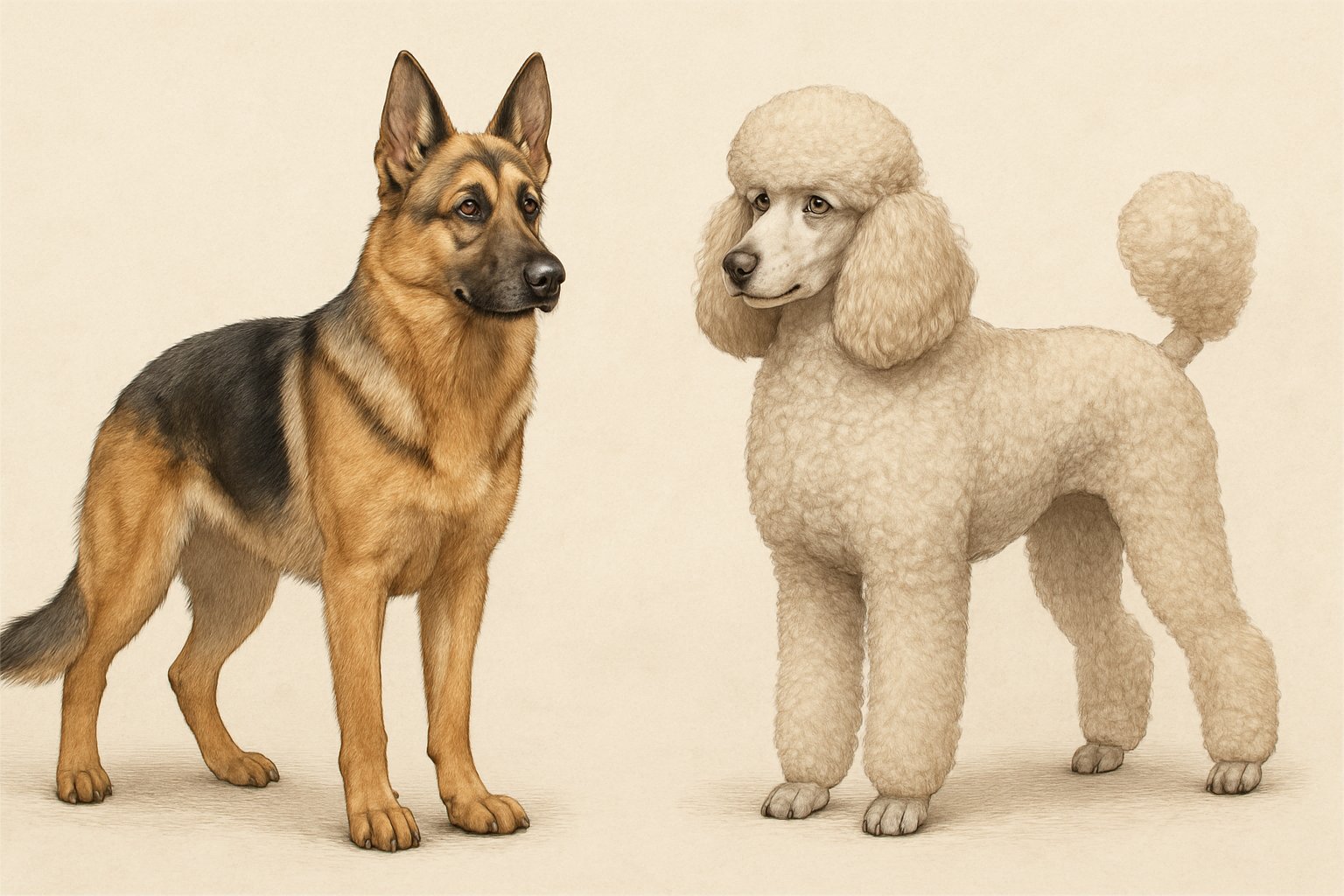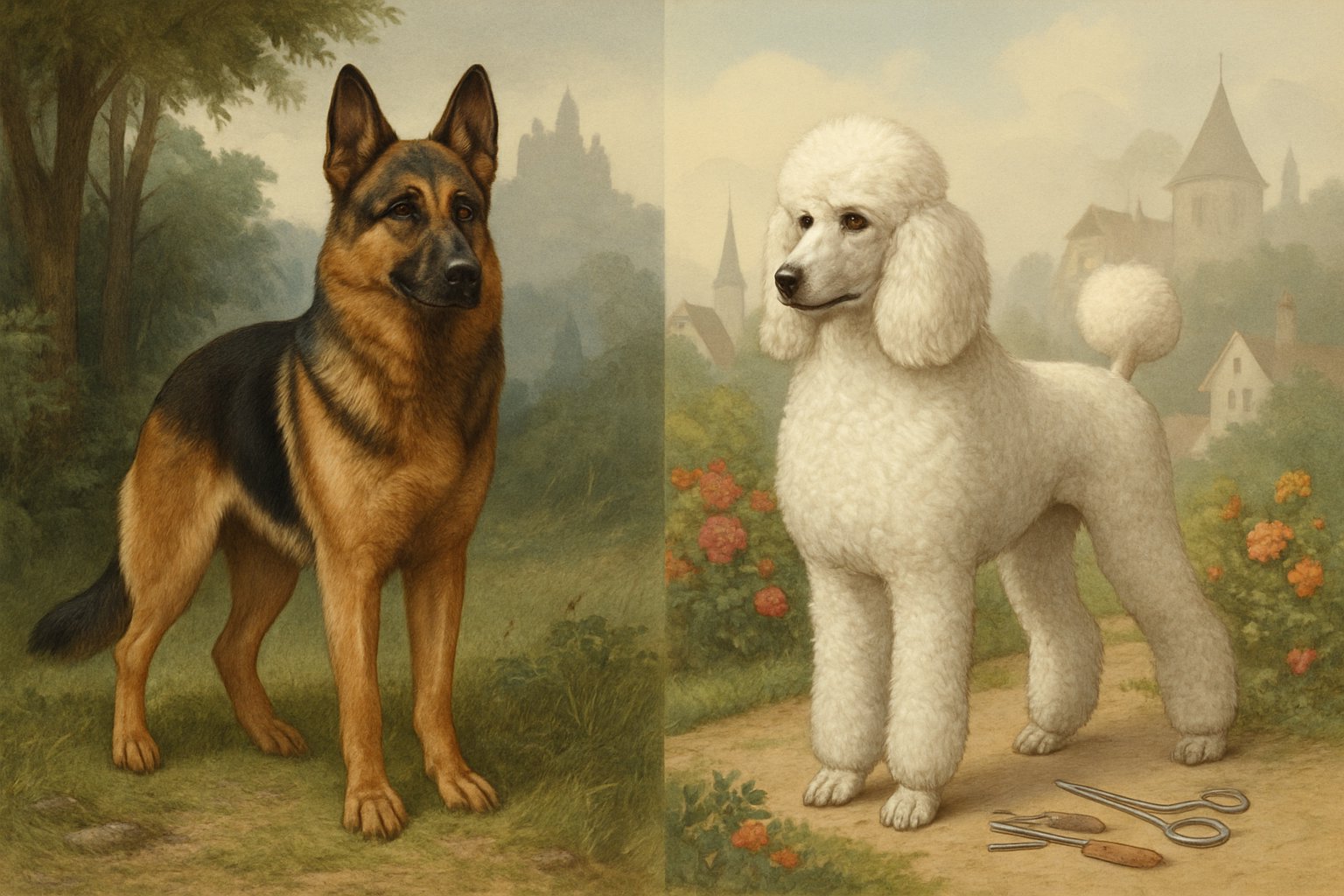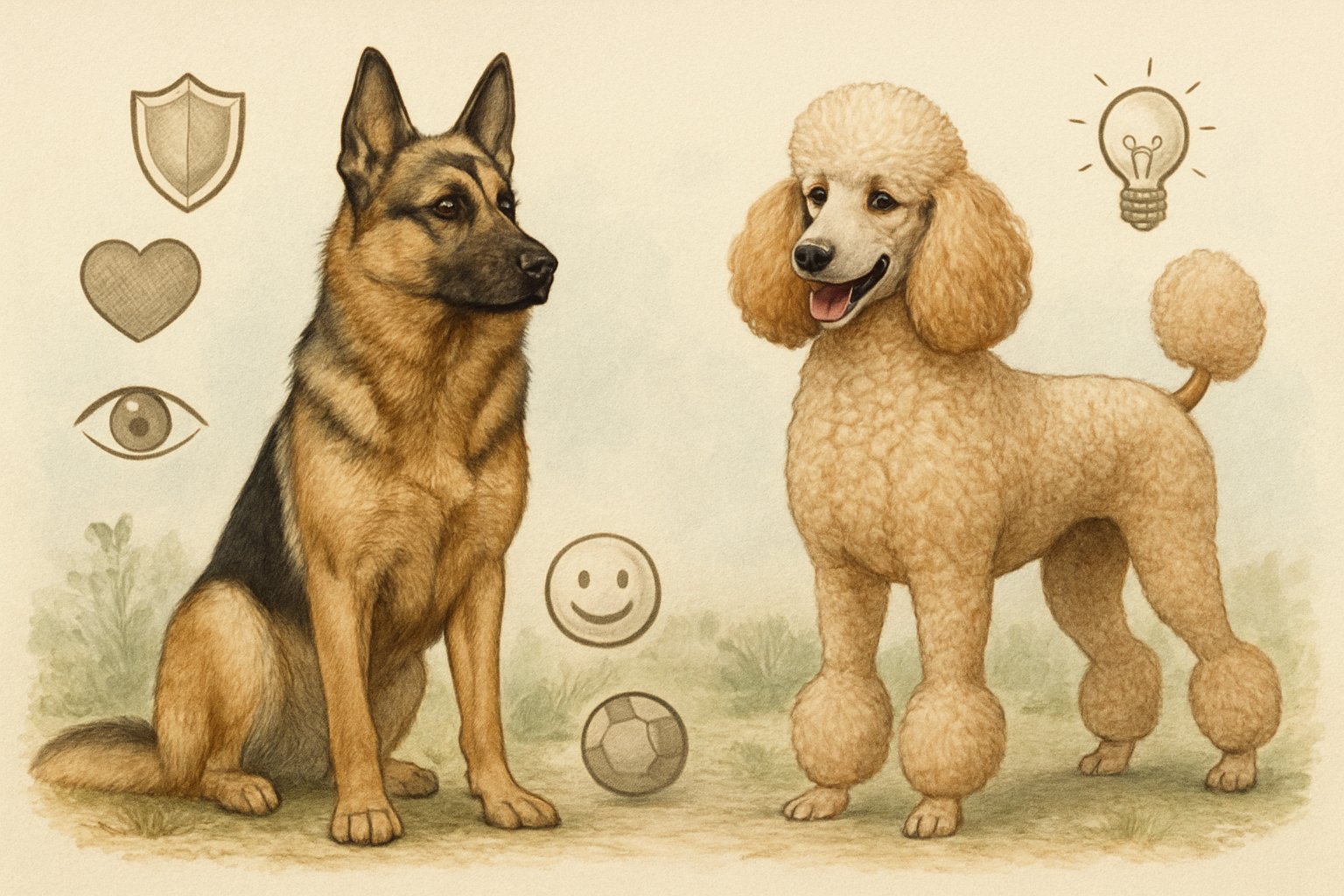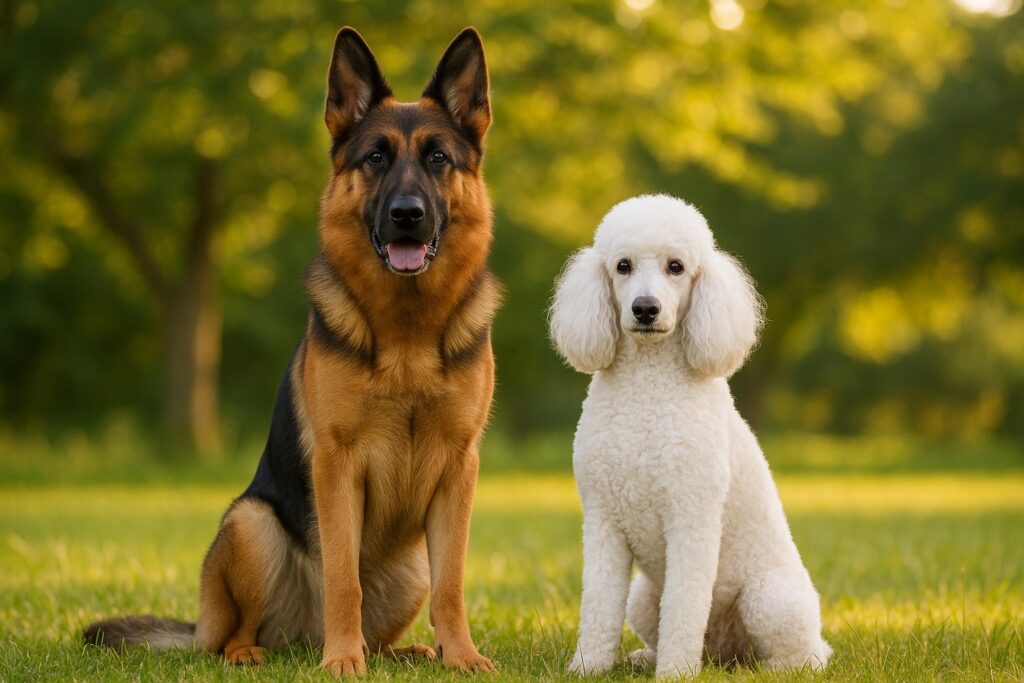Are you stuck between a German Shepherd and a Poodle? Both breeds are super popular, but their personalities and needs couldn’t be more different.
You want a loyal, smart dog, but their looks, quirks, and daily care won’t match every home. It’s a big choice.

German Shepherds and Poodles are loved worldwide. But their backgrounds and strengths? Not even close.
Each one brings its own set of challenges and perks. It really matters when you’re picking the right dog for your family.
Key Takeaways
- Every breed’s got its own history and look.
- Their personalities and care needs are pretty different.
- The right dog depends on your lifestyle and what your family wants.
Breed Origins and History

German Shepherds and Poodles started out with very different jobs. That history still shapes how they act today.
German Shepherd Background
The German Shepherd comes from Germany in the late 1800s. Max von Stephanitz, a cavalry officer, wanted the perfect herding dog.
He picked dogs for intelligence, strength, and obedience. Originally, they herded sheep.
Their skills quickly led them to police and military work. People saw them as loyal, hardworking, and brave.
Now, German Shepherds are famous as service dogs. You’ll spot them as police dogs, search and rescue dogs, and guide dogs for people with disabilities.
Poodle Background
The Poodle actually started out in Germany as a water retriever for hunting. Later, they became popular in France.
In France, people loved Poodles for their smarts and performing tricks. They became circus stars and favorites with royalty.
There are three main sizes: Standard, Miniature, and Toy. The Standard Poodle is the oldest and was bred for hunting and swimming.
Poodles are more than just show dogs. The Standard Poodle is athletic, strong, and quick to learn.
Their curly, low-shedding coat helped them in cold water. With their friendly nature and trainability, Poodles became a go-to for families and working roles like assistance and therapy dogs.
Physical Characteristics and Appearance

German Shepherds and Poodles look nothing alike. Their size, fur, and details really set them apart.
Some differences jump out right away. Others you only notice up close.
Size and Build Comparison
German Shepherds are big, strong dogs. Adult males usually stand 24–26 inches tall and weigh 65–90 pounds.
Females are a bit smaller. Their bodies are long and muscular, built for speed and endurance.
Standard Poodles are also a large breed, but lighter. They stand 18–24 inches tall and weigh 40–70 pounds.
Their build is more square, with long legs and a straight back. They look upright and elegant.
Quick Size Reference:
| Breed | Height (inches) | Weight (pounds) |
|---|---|---|
| German Shepherd | 22–26 | 50–90 |
| Standard Poodle | 18–24 | 40–70 |
Both breeds move with confidence. German Shepherds look rugged and muscular, while Poodles move with a lighter, almost bouncy step.
Coat Type and Colors
German Shepherds have a double coat. The outer layer is straight and dense, while the inner layer is softer and sheds a lot.
Most German Shepherds are tan and black or sable. Black and white coats are rare.
Poodles are known for their tight, curly coats. The curls help keep shedding down.
If you let their fur grow, it gets long and wooly. Poodles come in more colors—black, white, apricot, gray, brown, and more.
Key facts:
- German Shepherd: Straight, dense double coat; 2–3 color varieties.
- Poodle: Tight, curly single coat; lots of solid color options.
Distinguishing Features
German Shepherds have pointed ears and a bushy tail. Their sloped back and wolf-like face stand out.
They usually have a black mask on their face. Almond-shaped, dark eyes and strong jaws give them a serious look.
Poodles have a long, straight muzzle and oval eyes. Their ears hang close to the head, and their tails are carried high.
Show-style trims highlight their muscles and shape. You can spot a Poodle by its tight curls and proud, upright stance.
Temperament and Personality Traits

Both breeds are smart dogs. They’re popular family pets, but their personalities and energy levels are really different.
Intelligence and Trainability
German Shepherds learn fast and love to please. That’s why they work in police and military jobs.
They pick up basic and advanced training quickly. Clear commands and consistency work best.
Poodles are right up there in smarts. They can learn tricks and commands in no time.
Mental challenges like puzzle toys or agility courses keep them happy. Both breeds do best with regular, positive training.
If you want a dog that’s easy to train, you can’t go wrong here. Just know that their personalities need slightly different approaches.
Energy Levels and Activity Needs
German Shepherds have a ton of energy. They need lots of daily exercise to stay happy and out of trouble.
Long walks, runs, or play in a fenced yard are ideal. Without enough activity, they can get bored and destructive.
Standard Poodles are energetic too. They love swimming, running, and fetch.
Miniature and Toy Poodles need less exercise but still want playtime. If you’re an active family, either breed can keep up.
| Breed | Daily Exercise Needs | Activity Examples |
|---|---|---|
| German Shepherd | 1-2 hours | Hiking, running, obedience |
| Standard Poodle | 1-2 hours | Swimming, fetch, agility |
| Mini/Toy Poodle | 30 minutes – 1 hour | Short walks, play sessions |
Family Compatibility
German Shepherds are loyal and protective. They bond closely with their family and can be gentle with kids if they’re socialized early.
They might be wary of strangers at first. Poodles are friendly and playful, usually happy around both kids and adults.
Their low-shedding coats are great for families with allergies. Both breeds can be a handful with small kids—sometimes they get a bit too rowdy during play.
Socialization and Behavior
Early socialization is key for both breeds. Expose them to people, places, and other animals often.
German Shepherds can be aloof or overprotective if you skip socialization. Obedience classes and outings help a lot.
Poodles are usually outgoing and love meeting new people and dogs. Regular training and social time keep both breeds happy and well-mannered.
Health, Care, and Lifespan
German Shepherds and Poodles both need regular care to stay in good shape. Their grooming, exercise, and diet needs are different, and each breed faces some unique health issues.
Common Health Conditions
German Shepherds often struggle with hip and elbow dysplasia. That can mean joint pain as they get older.
They’re also at risk for degenerative myelopathy, a nerve disease that affects movement. Allergies, bloat, and some heart problems can crop up too.
Routine vet visits help catch issues early. Poodles are prone to eye problems like cataracts or progressive retinal atrophy.
Smaller Poodles may have dental issues and knee problems (patellar luxation). All sizes can get Addison’s disease and some skin conditions.
Regular health checks and screenings are important. German Shepherds usually live 9 to 13 years.
Standard Poodles live 12–15 years. Miniature and Toy Poodles can reach 14–18 years.
Grooming Requirements
German Shepherds shed—a lot. You’ll need to brush them several times a week, especially during shedding season.
Baths aren’t needed too often, just when they get dirty. Too many baths can dry out their skin.
Poodles have curly coats that barely shed, but they need more grooming. Daily brushing keeps mats and tangles away.
Most people take them to a groomer every 4–6 weeks, since their hair keeps growing. Don’t forget to clean their ears and trim nails regularly.
| Breed | Shedding Level | Brushing Frequency | Pro Grooming |
|---|---|---|---|
| German Shepherd | High | 2–3 times/week | Occasionally |
| Poodle | Low | Daily | Every 4–6 weeks |
Nutrition and Diet
Feed both breeds a high-quality dog food that matches their age and size. German Shepherds are big and active, so they need food that supports their joints and energy.
Watch how fast puppies grow—rapid growth can cause joint trouble. Poodles come in all sizes, so pick food that fits their needs.
Smaller Poodles burn energy faster and might need more frequent meals. Keep an eye on their weight, since extra pounds can lead to health issues.
Always make sure fresh water is available.
Exercise and Mental Stimulation
German Shepherds are working dogs with tons of energy. They need at least 1–2 hours of exercise every day.
Running, hiking, ball games, or obedience training all work well. They love having a job to do.
Poodles, especially Standards, also need plenty of exercise and mental challenges. Daily walks, play, and puzzle toys help burn energy.
Miniature and Toy Poodles don’t need as much intense activity but still want regular walks and games. Training classes and interactive toys help keep them busy and out of trouble.
Suitability for Families and Lifestyles
German Shepherds and Poodles each have their own strengths. The best fit depends on your family, how active you are, and where you live.
Family Pets and Children
Both German Shepherds and Poodles have earned their spot as family favorites. German Shepherds are loyal and protective, and they tend to form close bonds with kids.
They thrive in homes where people make time for training and play. If you’re a busy family, that’s something to keep in mind.
Poodles, especially the Standard and Miniature types, are friendly and gentle. They usually have the patience for children and might suit families who want a hypoallergenic pet.
Toy Poodles, though adorable, might not be the best match for really little kids because they’re so tiny.
Pros for Families:
- German Shepherd: Loyal, protective, active
- Poodle: Gentle, social, low-shedding
You’ll need to give both breeds enough exercise and keep an eye on interactions. They respond well to socialization, which helps them behave nicely around kids and visitors.
Working, Service, and Companion Roles
German Shepherds have a reputation as top service dogs. You’ll see them working with police, search-and-rescue teams, and as guides for people who are visually impaired.
Their intelligence and drive to work make them stand out in these roles.
Poodles can be excellent service and therapy animals too. Standard Poodles, in particular, get picked for assistance work because they’re smart and steady.
They sometimes visit hospitals, schools, or nursing homes as therapy dogs. That’s always a heartwarming sight.
Typical roles:
- German Shepherd: Policing, guarding, guiding
- Poodle: Therapy, assistance, emotional support
If you’re looking for a dog to help with work or service, both breeds have a lot to offer. German Shepherds do pop up more often in security roles, though.
Living Environment Considerations
Your living space really shapes your options here. German Shepherds love homes with a yard and plenty of room.
They can handle apartment life if you give them enough exercise. Still, they’re happiest when they’ve got space to roam.
Poodles, on the other hand, seem to settle in almost anywhere. Toy and Miniature Poodles especially fit right into smaller apartments.
All Poodles need daily walks and playtime. If they get bored, they might start barking or chewing—nobody wants that.
Key Points:
- German Shepherds: Need space and regular activity
- Poodles: Adaptable; lower-shedding coats; suit various home sizes
If you’re adopting from a shelter, take a good look at how active and social the dog is. Some pups just need more space or exercise than others.



